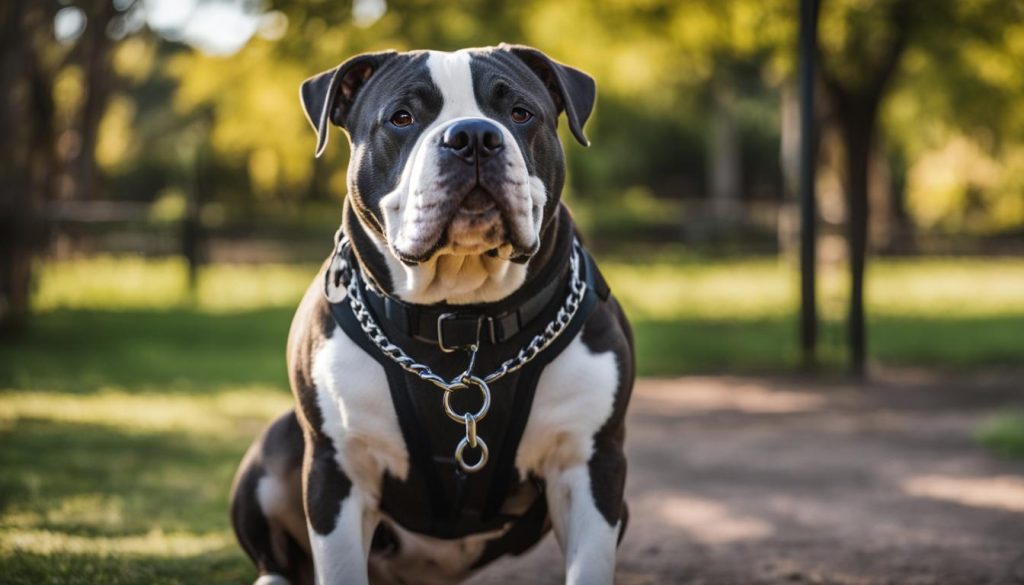The UK government’s recent announcement regarding the ban on American Bully XL dogs has raised concerns among dog owners in England and Wales. Starting from 31 December 2023, it will be illegal to breed, sell, advertise, rehome, abandon, or allow an American Bully XL dog to stray. This prohibition aims to ensure the safety and well-being of the public, as well as protect other animals from potential harm.
As responsible dog owners, it is important to understand the implications of this ban and comply with the new regulations. Here is what you need to know about the UK ban on American Bully XLs:
UK Parliament Bans XL Bully: Ban to kick in on 31 January 2024
The UK House of Commons passed new legislation to add the XL Bully into the list of dogs banned under the Dangerous Dogs Act 1991. From 1 February 2024 it will be a criminal offence to own an XL Bully dog in England and Wales unless your dog has a Certificate of Exemption. If you think that you may have an XL Bully dog, check the UK’s official definition of an XL Bully dog to see if your dog is affected.
If you own an XL Bully dog in the UK, it is now mandatory to get a Certificate of Exemption by 31 January 2024. To get a certificate of exemption, dog owners must ensure that their XL Bully dog is:
- Covered by third party liability insurance;
- Neutered permanently with confirmation from a vet;
- Pay a £92.40 fee for each dog that you keep; and
- Apply for a certificate of exemption (you can start the application process here)
In addition to the above, dog owners must ensure that their XL Bully is microchipped and kept on a lead and muzzled at all times when in public. XL Bully dogs must be kept in a safe place at all times where they cannot escape.
Dog owners who choose not to keep their XL Bully dog must take it to be euthanised at a registered vet practice by 31 January 2024 according to the UK’s government’s guidance.
Key Takeaways:
- UK government has added American Bully XL dogs to the banned breeds list.
- From 31 December 2023, breeding, selling, advertising, rehoming, abandoning, or allowing an American Bully XL dog to stray will be illegal.
- Owners must keep their American Bully XL dogs on a lead and muzzled in public.
- A Certificate of Exemption is required to legally own an American Bully XL dog from 1 February 2024.
- Owners have until 31 January 2024 to apply for the Certificate of Exemption.
What Happens if I Own an American Bully XL?

If you are currently an owner of an American Bully XL dog, it is important to understand the implications of the recent ban imposed by the UK government. Starting from 1 February 2024, it will be a criminal offense to own an American Bully XL without a Certificate of Exemption. To ensure compliance, owners must apply for this exemption by 31 January 2024.
In the meantime, there are certain measures that need to be taken if you own an American Bully XL. Your dog must be microchipped, neutered, and kept on a lead and muzzled while in public. It is also crucial to keep your dog in a secure place and have third-party liability insurance against any potential injuries caused by your dog to others. Additionally, you must be over 16 years old to legally own an American Bully XL. Lastly, it is important to note that you may be asked to present your Certificate of Exemption to a police officer or a council dog warden, so ensure you have it readily available.
It is vital for American Bully XL owners to adhere to these regulations to avoid legal trouble and potential consequences. Failure to comply with the ban and obtain the necessary exemption may result in penalties or even the seizure of your dog.
Table: Summary of Requirements for American Bully XL Owners
| Requirement | Deadline |
|---|---|
| Apply for Certificate of Exemption | By 31 January 2024 |
| Microchip your dog | Before 1 February 2024 |
| Neuter your dog | Before 1 February 2024 |
| Keep your dog on a lead and muzzled in public | Starting from 1 February 2024 |
| Provide third-party liability insurance | Starting from 1 February 2024 |
| Keep your dog in a secure place | Starting from 1 February 2024 |
How to Determine if Your Dog is an American Bully XL
If you are uncertain whether your dog falls under the classification of an American Bully XL, the UK government has provided an official definition based on specific physical characteristics. These characteristics include the height, bite, coat, croup, forequarters, hindquarters, loin, muzzle, pasterns, scissor bite, spring of rib, tail set, topline, and withers. By referring to this definition, you can determine if your dog is classified as an American Bully XL.
Height is a crucial factor in determining if a dog is an American Bully XL. If your dog is smaller than the specified height, it is not classified as an American Bully XL. However, it is important to note that the law focuses on the type of dog rather than the breed itself. Therefore, physical characteristics, such as size and height, play a significant role in classifying a dog as an American Bully XL.
Examples of Physical Characteristics:
- Height: Must meet or exceed a specific height requirement
- Bite: Specific type of bite is characteristic of an American Bully XL
- Coat: Unique coat characteristics distinguish an American Bully XL
- Croup: Defined croup shape is a feature of an American Bully XL
- Forequarters: Specific structure of the forequarters is associated with an American Bully XL
- Hindquarters: Distinctive hindquarter structure is indicative of an American Bully XL
- Loin: Unique loin structure is seen in an American Bully XL
- Muzzle: Specific muzzle shape and length define an American Bully XL
- Pasterns: Defined pastern shape is characteristic of an American Bully XL
- Scissor Bite: Specific bite type is associated with an American Bully XL
- Spring of Rib: Unique rib structure is seen in an American Bully XL
- Tail Set: Distinctive tail set is a feature of an American Bully XL
- Topline: Specific topline structure is associated with an American Bully XL
- Withers: Unique withers structure distinguishes an American Bully XL
By considering these physical characteristics, you can determine if your dog is classified as an American Bully XL. Remember to refer to the official definition provided by the UK government for a comprehensive understanding.
How to Apply for a Certificate of Exemption

Applying for a Certificate of Exemption
If you own an American Bully XL dog in the UK, it is crucial to apply for a Certificate of Exemption to keep your dog legally. The application process can be completed online through the government’s website or by downloading and mailing the application form. The deadline for online applications is 12 noon on 31 January 2024, while for mailed applications, the form must arrive before 15 January 2024.
Each American Bully XL dog requires a separate application, with a maximum of three dogs allowed per online application and up to 30 dogs per mailed application. Along with the application form, you will need to pay the application fee, provide proof of third-party public liability insurance for your dog, and provide the dog’s microchip number.
Additionally, it is important to ensure that your American Bully XL dog is neutered. You will also need to complete a VCN01 form, which details the dog’s age, and submit it to the government by specific deadlines based on the dog’s age.
Table: Application Deadlines for American Bully XL Dogs
| Age of the Dog | Deadline for VCN01 Form Submission |
|---|---|
| Under 4 months old | 30 days after turning 4 months old |
| 4 – 8 months old | 30 days from the date of application |
| Over 8 months old | 30 days from the date of application |
It is important to ensure that you meet all the requirements and submit the necessary documentation within the specified deadlines to avoid any legal complications or penalties.
Summary
To keep your American Bully XL dog legally in the UK, you need to apply for a Certificate of Exemption. The application can be submitted online or by mail, with specific deadlines for each. Remember to pay the application fee, provide proof of third-party public liability insurance, and provide your dog’s microchip number. Neutering your dog is also a requirement, and you must submit the VCN01 form based on your dog’s age. Ensuring compliance with the application process and meeting all the requirements will help you keep your American Bully XL dog legally and avoid any legal issues.
Other Banned Breeds in the UK

In addition to the American Bully XL, there are several other dog breeds that are banned in the UK under the Dangerous Dogs Act 1991. These breeds include the Pit Bull Terrier, Japanese Tosa, Dogo Argentino, and Fila Brasileiro. The ban on these breeds prohibits breeding, selling, giving away, or abandoning them. If an owner of one of these banned breeds does not have a Certificate of Exemption, the police have the authority to seize the dog.
The UK government’s decision to ban these breeds is based on concerns about their potential for aggression and the risk they pose to public safety. However, critics argue that breed-specific bans are ineffective in addressing the root causes of dog aggression. Organizations like Battersea believe that a more comprehensive approach is needed, focusing on responsible ownership and early interventions to prevent and address aggression in all dogs, regardless of breed.
While the ban on American Bully XLs is a significant development, it is important to remember that there are already restrictions on other breeds in the UK. It is crucial for dog owners to be aware of these restrictions and to ensure that they are in compliance with the law. Responsible ownership, training, and socialization are key factors in promoting the safety and well-being of all dogs and the general public.
Table: Banned Dog Breeds in the UK
Below is a table summarizing the banned dog breeds in the UK, including the American Bully XL:
| Banned Breed | Restrictions |
|---|---|
| American Bully XL | Banned from breeding, selling, advertising, rehoming, or allowing to stray. Must be kept on a lead and muzzled in public. Requires a Certificate of Exemption to own. |
| Pit Bull Terrier | Banned from breeding, selling, giving away, or abandoning. Requires a Certificate of Exemption to own. |
| Japanese Tosa | Banned from breeding, selling, giving away, or abandoning. Requires a Certificate of Exemption to own. |
| Dogo Argentino | Banned from breeding, selling, giving away, or abandoning. Requires a Certificate of Exemption to own. |
| Fila Brasileiro | Banned from breeding, selling, giving away, or abandoning. Requires a Certificate of Exemption to own. |
Battersea’s View on the Proposed Ban

Battersea, a renowned animal welfare organization, shares its perspective on the proposed ban on American Bully XL dogs in the UK. They believe that breed-specific bans are ineffective in addressing dog bite incidents and that a more comprehensive approach is needed.
“Focusing solely on certain breeds does not address the root causes of aggression in dogs,” says Battersea spokesperson. “We firmly believe that aggressive behavior should be dealt with on a case-by-case basis, taking into consideration individual circumstances and responsible ownership.”
Battersea advocates for effective enforcement of existing laws and early interventions to prevent dog aggression. They suggest that the government should prioritize addressing issues related to owners whose dogs are dangerously out of control and breeders who exploit dogs for profit.
The organization emphasizes the importance of responsible ownership and promoting positive training methods to ensure the well-being of all dog breeds, including American Bully XLs. They believe in encouraging responsible dog ownership through education, support, and training initiatives to prevent incidents and promote a safe and harmonious environment for both dogs and the public.
Battersea’s Key Points:
- Breed-specific bans are ineffective in addressing dog bite incidents.
- A comprehensive approach and responsible ownership are crucial.
- Dealing with aggression on a case-by-case basis is more effective.
- Effective enforcement and early interventions are essential.
- Promoting responsible ownership and positive training methods is vital.
Support for American Bully XL Owners

As the ban on American Bully XL dogs in the UK approaches, it’s important for owners to know that they are not alone in navigating this change. Dogs Trust, a prominent dog welfare charity, is providing support and resources to assist American Bully XL owners during this transition period. Their aim is to ensure that owners have the information and guidance they need to adhere to the new regulations and provide the best care for their dogs.
Dogs Trust offers a range of services to help American Bully XL owners. They provide detailed information on the ban and help owners understand the steps they need to take to comply with the law. The charity also assists with the application process for a Certificate of Exemption, which is required for owners to legally keep their American Bully XL dogs. Additionally, Dogs Trust offers guidance on general dog care and training, ensuring that owners have access to the resources they need to provide a safe and enriching environment for their pets.
Furthermore, Dogs Trust conducts free classes for American Bully XL owners, focusing on responsible ownership and training techniques. These classes not only help owners meet the legal requirements but also provide valuable knowledge and skills to promote positive behavior and prevent potential issues. By offering support and education, Dogs Trust aims to empower American Bully XL owners to be responsible and knowledgeable dog guardians.
In this challenging time of change, it is comforting to know that organizations like Dogs Trust are there to provide assistance and support. By taking advantage of the resources available, American Bully XL owners can navigate the ban with confidence, ensuring the well-being and happiness of their beloved pets.
Choosing the Right Muzzle for an American Bully XL

When it comes to complying with the UK ban on American Bully XL dogs, one important aspect for owners is the choice of muzzle. Muzzling is a requirement for American Bully XLs when in public, and it’s crucial to select the right type of muzzle to ensure the comfort and safety of the dog. Battersea, a well-known animal welfare organization, recommends using a basket-type muzzle for American Bully XL dogs.
The basket-type muzzle is a preferred option as it allows the dog to pant and drink freely, ensuring that their basic needs are met. Furthermore, this type of muzzle enables owners to provide treats to their dogs while wearing the muzzle, making the experience more positive for the dog. It is essential to take accurate measurements of the dog’s nose width and length to choose the appropriate size of muzzle, ensuring a proper fit that neither restricts nor causes discomfort to the dog.
Wrapping Up
To summarize, the UK government’s decision to implement a ban on American Bully XL dogs in England and Wales has significant implications for dog owners. The ban will come into effect on 31 December 2023, making it illegal to breed, sell, advertise, rehome, abandon, or allow an American Bully XL dog to stray. From 1 February 2024, owning an American Bully XL without a Certificate of Exemption will be a criminal offense.
To comply with the new legislation, owners must ensure their American Bully XL dogs are microchipped, neutered, kept on a lead, and muzzled in public. It is also vital to apply for a Certificate of Exemption before the deadline of 31 January 2024. This exemption certificate can be obtained by submitting an application online or by mail, along with the required documents and application fee.
Responsible ownership is crucial during this transition, not only to comply with the law but also to ensure the safety and well-being of American Bully XL dogs and the general public. Organizations like Dogs Trust and Battersea offer support, guidance, and resources to American Bully XL owners, assisting them in navigating this ban effectively. By working together, we can ensure a smooth transition and promote responsible dog ownership for the benefit of all.
FAQ
What happens if I own an American Bully XL?
Starting from 1 February 2024, it will be a criminal offense to own an American Bully XL dog without a Certificate of Exemption. Until then, owners need to ensure their dogs are microchipped, neutered, kept on a lead and muzzled in public, and kept in a secure place. Owners must also have third-party liability insurance against their dog injuring other people and be over 16 years old. If asked, owners must show the Certificate of Exemption to a police officer or a council dog warden.
How can I determine if my dog is an American Bully XL?
The UK government has provided an official definition of an American Bully XL based on physical characteristics. Height is an important factor, and if a dog is smaller than the specified height, it is not classified as an American Bully XL. The government’s definition also includes details on bite, coat, croup, forequarters, hindquarters, loin, muzzle, pasterns, scissor bite, spring of rib, tail set, topline, and withers. Dog owners can refer to this definition to determine if their dog falls under the American Bully XL classification.
How do I apply for a Certificate of Exemption?
To keep an American Bully XL dog legally, owners need to apply for a Certificate of Exemption. Applications can be submitted online through the government’s website or by downloading and mailing the application form. The deadline for online applications is 12 noon on 31 January 2024, and for mailed applications, the form must arrive before 15 January 2024. Each dog requires a separate application, with a maximum of three dogs allowed per online application and up to 30 dogs per mailed application. Along with the application, owners need to pay the application fee, provide proof of third-party public liability insurance, and provide the dog’s microchip number. Owners also need to ensure their dog is neutered and complete a VCN01 form to be submitted to the government by specific deadlines based on the dog’s age.
What other breeds are banned in the UK?
The Dangerous Dogs Act 1991 already bans other breed types in the UK, including the Pit Bull Terrier, Japanese Tosa, Dogo Argentino, and Fila Brasileiro. It is illegal to breed, sell, give away, or abandon these banned types of dogs. If an owner of a banned breed does not have a Certificate of Exemption, the police can seize the dog.
What is Battersea’s view on the proposed ban?
Battersea, a renowned animal welfare organization, believes that breed-specific bans are ineffective in tackling dog bite incidents. They argue that focusing on certain breeds does not address the root causes of aggression and that more effective enforcement and early interventions are needed. Battersea advocates for dealing with aggression in all dogs on a case-by-case basis and promoting responsible ownership. They believe that the government should focus on owners whose dogs are dangerously out of control and breeders who exploit dogs for profit.
Is there support available for American Bully XL owners?
Dogs Trust, a prominent dog welfare charity, offers support to American Bully XL owners. They provide information about preparing for the ban, assistance in applying for a Certificate of Exemption, guidance on dog care and training, and free classes for American Bully XL owners. Dogs Trust emphasizes the importance of responsible ownership and the need to ensure dogs are microchipped, neutered, and trained to wear a muzzle.
How do I choose the right muzzle for an American Bully XL?
Battersea recommends using a basket-type muzzle for American Bully XL dogs. This type of muzzle allows the dog to pant and drink freely and enables the owner to feed the dog treats while wearing the muzzle. It is important to ensure that the muzzle fits correctly and does not cause discomfort to the dog. Measurements of the dog’s nose width and length are necessary to choose the right size muzzle.






